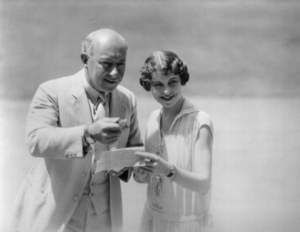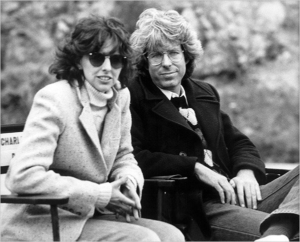The Art of Collaboration: Jeanie Macpherson and Nancy Meyers
Filmmaking, by nature, is a collaborative industry. Creating a successful film is difficult, and doing it yourself is near impossible. Collaboration helps an artist improve their own voice. Women screenwriters are at a disadvantage due to their gender. Their pieces are the last to be financed, collaborated with and successfully brought to screen. Jeanie Macpherson and Cecil B. DeMille, rumored to be romantically involved, collaborated on a unique range of films that spanned over 30 years. Nancy Meyers and Charles Shyer married each other, in 1980, the same time their first collaborative film was released. They would continue creating films together until their divorce 19 years later, at which point Meyers would take full creative control, directing and writing her own pieces. By writing their screenplays and collaborating with male filmmakers, Macpherson and Meyers demonstrate the power of working together and the art of collaboration.

Jeanie Macpherson began her career as an actress and singer before finding her passion in screenwriting. In 1914, Cecil B. DeMille cast Jeanie in his film, Rose of the Rancho. After the film, DeMille, interested in Macpherson’s writing, hired her as a writer. Individually, they were creative with their own unique styles. Together, their relationship was both complementary and turbulent. DeMille said, “when [Jeanie Macpherson] got her fangs into anything you could not shake her loose. I fired her regularly but it did no good, for she would always come back with another version of the script.” That persistence helped create 39 films that started in 1915 and ended during the 1940s.
Macpherson’s real genius was that she understood what DeMille wanted and she knew how to put it on paper; however, it did not come easy. “The first time I submitted a scenario to Cecil B. DeMille he ironically informed me that I had plenty of imagination but wrote like a carpenter”, Macpherson wrote. The relationship a screenwriter has with a director is incredibly important to a film’s success. If there is an absence of understanding between the two members, the picture becomes confusing and distant to an audience.
One of the initial themes of Macpherson’s work that peaked DeMille’s interest was her focus on characters. The juxtaposition between DeMille’s direction and Macpherson’s intimate writing was the template of their joint films. The 1927 film, King of Kings, which DeMille directed and Macpherson wrote, tells the story of Christ but with a characterization that was previously unknown in cinema. Macpherson also pushed the idea of sex appeal being shown to an audience through contemporary stories, which was new to DeMille.
DeMille’s behavior towards Macpherson was a mix of hot and cold attitude. Yet despite the challenges, they were rumored to be romantically involved, something that was considered an open secret in Hollywood at the time. Cari Beauchamp wrote that despite the publicity of their romance, “there was never an inference that Jeanie was hired because of their affair and not her talent; DeMille would have many mistresses but few scenario writers”.

Nancy Meyers and Charles Shyer’s collaboration was less controversial compared to Macpherson and DeMille. Nancy Meyers graduated with a degree in journalism before working in public television in Philadelphia, PA. She eventually worked as a story editor and began writing her own scripts. Meyers was introduced to Charles Shyer and they, along with Harvey Miller, created the 1980 film, Private Benjamin. Together, their film grossed 70 million dollars in the US market and was nominated for three Academy Awards. Over the span of their 19-year marriage, they would co-write twelve films, many of which Shyer directed.
Their films coincide with their lives together and their friends’. Meyers was pregnant with their child when they co-wrote Baby Boom in 1987. A film that tells the story of a working woman who is forced to reconsider her life for her toddler god-daughter, may not be an identical situation many woman experience. However, the struggle of finding a balance between work and home life is something many women face. Similarly, their 1991 film, Father of the Bride, shows the challenge of dealing with a father’s only daughter getting married. Through comedy, Meyers and Shyer show compassion and a conversation of masculinity in a way that is related to many fathers.
Meyers and Shyer’s marriage ended in 1999 and so did their collaborations. After their divorce, Meyers was unsure if she could write by herself. She said it wasn’t a “rebirth”, continuing her career alone. Instead, it was something she had no other choice to do. She continued her career by writing and directing her own pictures, maintaining her interest in real women dealing with real problems. Her first film post-divorce, Something’s Gotta Give was completed in 2003. It shows the challenge older women face when they become involved with someone later in their lives. While Meyers is private and never married after Shyer, it is not uncommon for her to gain inspiration for her work through her own life or lives around hers.
The real “art” of these women’s collaborations is that they understood opportunity without allowing themselves to fall victim to the industry. While both women struggled with their own challenges personally and professionally. Nancy Meyers worked on a fraction of the work Jeanie Macpherson worked on and perhaps that was due to the lack of funding or recognition from her counterparts. Meanwhile, according to Macpherson’s IMDB page, she is considered uncredited for much of her work, also maybe from lack of recognition in the industry. Either way, both women also avoided becoming stereotypes and fought against them in their works. In their own ways, they paved the way for women representation in media and among professionals. The “art” is what they have given to the world of cinema on-screen and off.
Both Jeanie Macpherson and Nancy Meyers collaborated with men in two different ways. Yet, together they worked their way to be able to write films that they felt passionate about. Both women’s careers continued and arguably advanced after their male collaborators ended. So what does this mean for women screenwriters in 2017? It is important to see through Jeanie and Nancy’s experiences how one can collaborate with men and maintain their feminine gaze. Women writers and those in other roles in the industry should feel empowered to not look at themselves as underdogs but instead, take control and join forces to create art that represents change and equality.
Works Cited
Larocca, A. “In Conversation with Nancy Meyers.” Vulture.com. Sept. 2015. Web.
Nelmes, J., Selbo, J. “Jeanie Macpherson.” Women Screenwriters: An International Guide. Basingstoke, Hampshire: Palgrave Macmillan, 2015. Print.
What do you think? Leave a comment.










I had a hard time watching Something’s Gotta Give because of Jack Nicholson, who I think is kind of creepy; and I’ve never watched It’s Complicated due to the presence of Alec Baldwin who I also have a hard time watching. A couple of year ago my mom and I tried brainstorming a list of attractive older male actors who would be better for wooing Diane Keaton on-screen and we had a hard time with that. But just watching the trailer for her newest one with DeNiro makes me wish that Nancy Meyers would make a rom com with him and Diane Keaton as the two leads.
I think a female director would do a great job directing an action or superhero movie – they simply aren’t given the chance to do so.
I agree, look what Patty Jenkins did with Wonder Woman. Looking forward, I think the industry needs to figure out why women are not given the chance and fix that.
I miss the silent film era.
Yes, some great films from that era. One of my personal favorites is Jeanie Macpherson’s The Godless Girl. What an interesting and controversial idea that was from 1929!
Great post. I want to watch “The Taming of the Shrew” with Jeanie which is based on a Shakespeare play.
What a great topic and extremely well-written. I love your conclusion as a guiding point for women and our position today.
Thanks for an article that is at once realistic and inspiring.
Favorite quote of Jeanie Macpherson:
“Each scene must be a drama in itself. The whole picture must be made up of a series of small dramas.”
WOW. I never heard that. Looking back at her work you can see the visualization of mini-dramas composed in a feature. So cool.
Jeanie was a great screenwriter and most famous for her work with Cecil B. DeMille.
I really enjoyed this article. Nancy Meyers films have become like comfort food to me, insofar as I even binge on them when home sick.
Used to resent Meyers because she seemed completely out of touch with anybody who doesn’t have money, but screw it–she makes the comfiest movies ever.
Totally agree. I think that’s an ok thing as long as we acknowledge the lack of diversity and press for change.
I’m curious about the connection between Baby Boom and The Intern. Anne Hathaway was born just a few years before Baby Boom was made. In theory, her character for the Intern could be the full circle for the adopted daughter in Baby Boom now as an adult. I wonder if this was a conscious decision on Meyers party?
Nancy has written and directed some of the best films with female lead over the age of 45.
I love these womens’ movies. And yeah, more women should be directing movies.
I’m all for seeing more women in Hollywood, especially in writing. I’m also ready to see them move out from the current self deprecating themes that seem to be at the current forefront in the writing of women, but I understand it’s a foot in the door technique.
Absolutely. As a woman, I relate to films with a female lead. However, my life doesn’t revolve around a lot of themes present in the past and current female-lead films.
I’d love to know Nancy’s thoughts on racial diversity in Hollywood films and why she’s actively chosen to populate all of her movies solely with rich white people.
YES. It’s a sensitive subject in feminist film and feminism as a whole. I love her films but how long do we have to wait for a more diverse cast. All her storylines are relatively universal, no?
Meyer’s movies are irresistibly charismatic.
The Captive (1915) is pretty great!
Thank you for highlighting these talents.
I think all women back then got into the writing by doing performance first.
It was one of the few things creative women were encouraged to do. I find that even today. Society loves a young, beautiful female actor. But a female writer, they get less attention.
Both women are candid and smart.
Two stellar power couples!